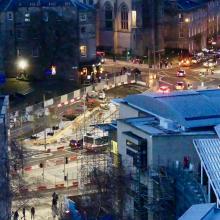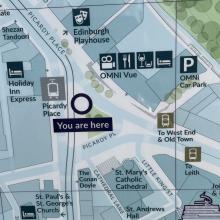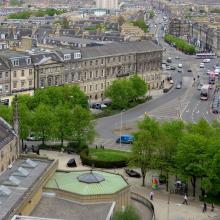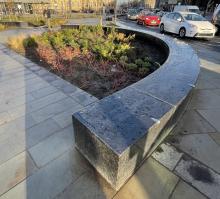
DIRECTOR OF DEVELOPMENT BRIEFS LOCALS
Martin Perry, Director of Development at TH Real Estate (THRE), spoke about the St James Quarter (SJQ) project after Monday night’s Annual General Meeting of the Leith Central Community Council (LCCC).
Owing to the number and urgency of questions from the floor, he was unable to complete his presentation.
However, he had many noteworthy points, most of which we summarise below in roughly the order he made them.

Background
THRE is the third largest property company in the world, and is owned by the USA’s biggest pension fund. Its global involvement in other funds means that, if you have any kind of pension other than a state one, it is likely to be partially tied up with THRE and so the St James Quarter.
As a pension fund rather than simply a property developer, THRE is not interested in making a quick buck and walking away. The intention is to profitably manage the SJQ over the next 40–50 years or more after the new shopping/ residential/ leisure centre is completed.
THRE therefore has a vested interest in getting things right.
The total development will run to around 1.7 million square feet with a footprint of just under 7 acres. Of that, 850,000 square feet will be retail.
The project currently involves around 400 staff, with that figure rising to 5,000 during construction. It is estimated to create 3,000 permanent jobs once completed.
£850m is invested in the scheme. Last year, SJQ accounted for 75% of inward investment into Scotland. (Inward investment here has stalled, partly due to residential developers’ concern that the Scottish Government may introduce rent controls.)

Why Edinburgh?
THRE looks at ‘mega trends over the long term’, and has identified Edinburgh as a key destination that will continue to attract visitors.
By clustering attractions in the SJQ (shops, hotels, leisure, restaurants, cinemas) it will create a healthy commercial ecosystem where people will want to spend time. For this reason, THRE is not concerned by the increasing mega-trend of consumers buying products online.
In the UK, there are currently 1.75 square metres of retail space per person. There is therefore ample potential to move towards the equivalent 11.5 square metres per person found in the USA. [Spurtle note to self: big-boned Americans need more room to waddle about in.]
THRE is considering improvements to the OMNi Centre (which it bought in January 2017) including, perhaps a weekly food market on the Greenside concourse.
Aim is for SJQ to improve physical and cultural permeability between city centre and Leith.

Leith Street
The appearance of the street will be improved by the introduction of much stone and granite for surfaces. Central railing will be removed.
Public transport, bicycles (2 lanes) and pedestrians will be prioritised over cars in the final scheme.
The road surface will rise by up to 800mm in some places.
The £5m works here were necessitated by unexpectedly complicated and decrepit underground infrastructure, including multiple, abandoned cast-iron pipes, tramlines, collapsing cellars, and a leaking, Victorian, brick-built sewer.
Services replaced now will last long into the future and reduce disruption in years to come.
The sewer, descending at a leisurely poo-friendly incline of 1 in 40, is buried 6 metres underground at the top of Leith Street. Excavation (and the pressure of nearby traffic) must be handled with great care here for the safety of workers. Hence the requirement to close the thoroughfare.
There is simply not enough space in Leith Street to speed up progress by throwing more workers into the hole.
The bridge will be dismantled/removed in the week beginning 23 June. It’s a bespoke structure without any obvious use elsewhere. Too expensive to adapt. It will be sold for scrap.

Closure
A decision to green-light the temporary closure of Leith Street was delayed by politicians dragging their heels in the run-up to Council elections. Public consultation was drastically curtailed because of need to stay on legally agreed schedule.
Contractors had initially wanted a year for the work. Politicians argued for a reduction to 44 weeks (starting after the 2017 Festival).
Closure will result in improved conditions for pedestrians (compared to the current overcrowded pavement). Events will be organised to encourage public use of the street during this period.
Paradoxically, traffic modelling suggests closure/diversion will actually increase road capacity for private vehicles.
Closure is predicted by Lothian Transport to add 6-minutes to bus-journey times, but if the diversions fail to keep traffic running smoothly then the arrangements will be adjusted.
‘44-weeks is very tight,’ says Perry. If Leith Street work looks likely to overrun, CEC will allow contractors to operate on Saturday afternoons and Sundays.
[For more detail, see 21 March report to Transport & Environment Committee, attached at foot of this page.]

Disruption
Members of the public and LCCC complained about the current and coming combined effects of the SJQ, Leith Walk Programme (LWP) and Shrub Place construction. Downturn in footfall and trade on Leith Walk. (LCCC estimates SJQ will delay completion of LWP by at least a year.)
Could: (a) SJQ work be delayed to allow completion of LWP first? (b) THRE donate money/manpower (in compensation) to speed up LWP? Perry said a delay to SJQ was unthinkable for investors who had already waited 10 years during the planning stage. Whilst sympathising with problems encountered on Leith Walk, he and THRE were not responsible for projects elsewhere. THRE is not a charity.
THRE is already underwriting any loss of profits for John Lewis during the demolition/ construction phase.
THRE is trying to reduce demolition-related traffic along Leith Walk by investigating how to crush more rubble on-site. Water-suppression of dust will continue to be strictly applied during demolition.
THRE (and Perry, personally) are regularly checking Leith Walk for any damage caused by contractors’ lorries, and THRE will cover cost of necessary remedial works.

Picardy Place
Design here is still in progress, but THRE sees it as a vital interchange for buses, trams and bicycles. THRE has always planned on the assumption that trams will be extended as far as Newhaven at least.
Not only but also …
Perry let slip another observation which many local residents will find interesting … when we reveal it in Spurtle’s printed Issue 263 on 1 June.

--------------------







